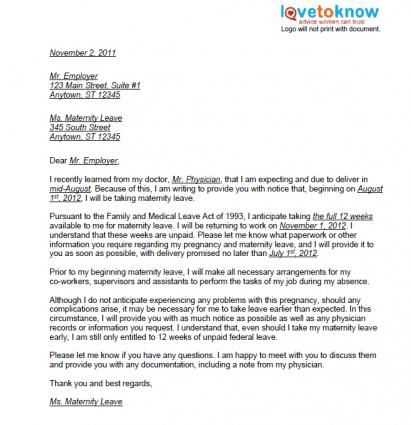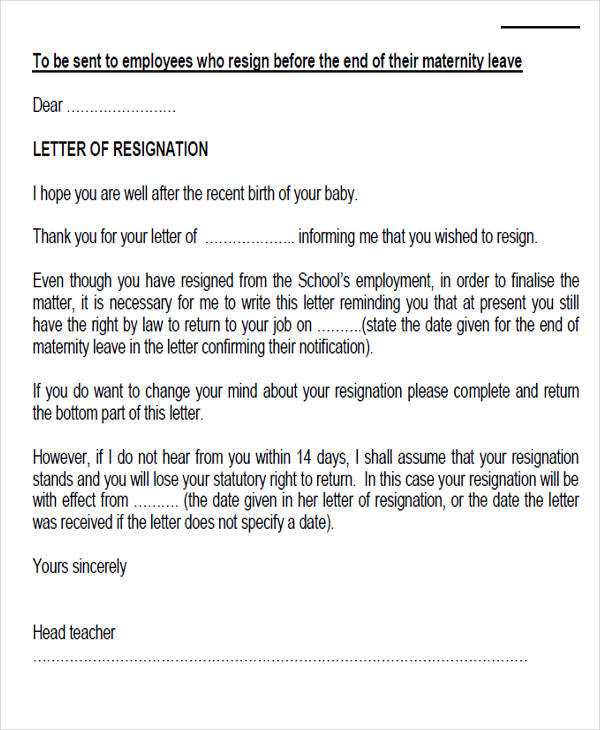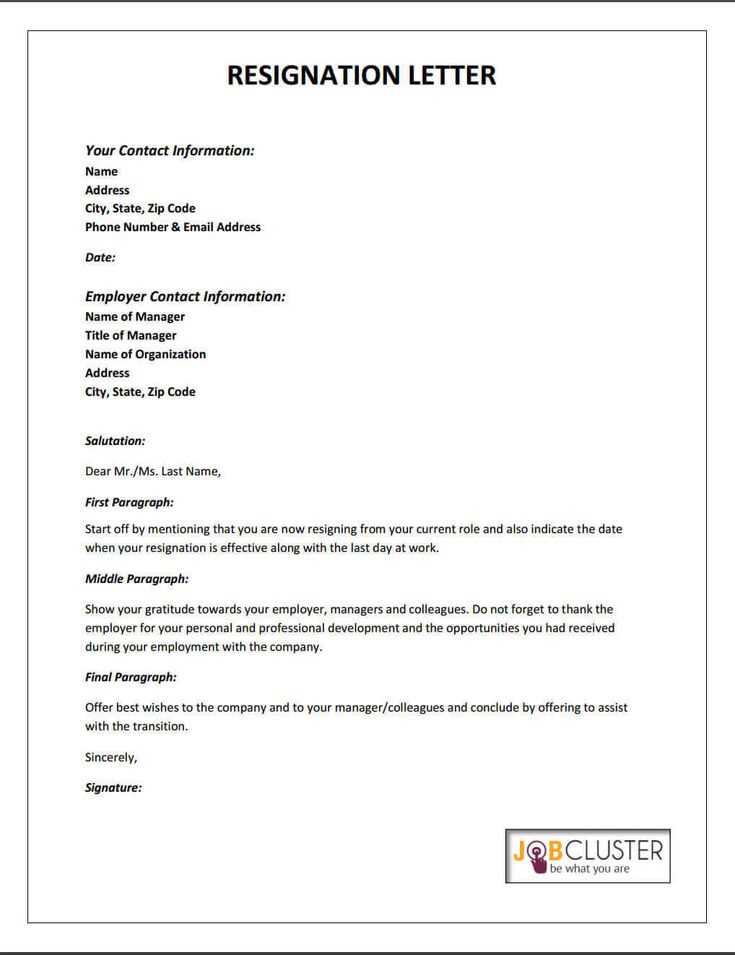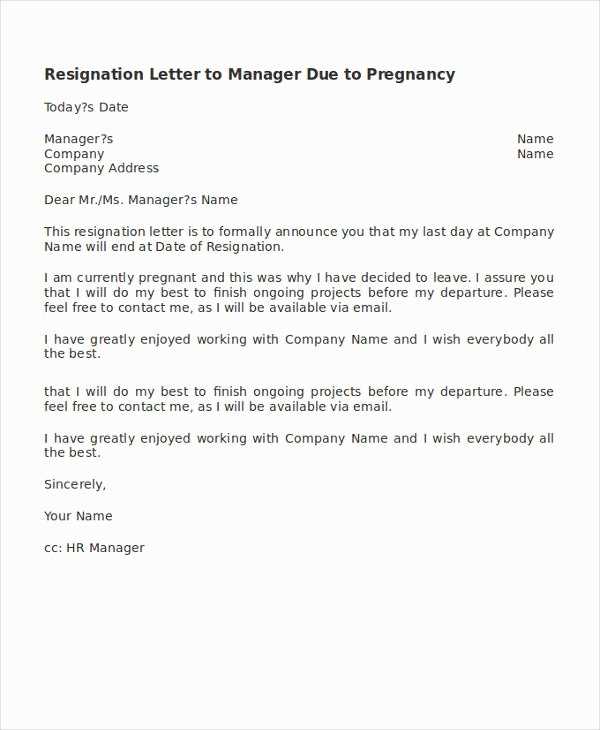Maternity leave resignation letter template

If you’re planning to resign from your job due to maternity leave, it’s key to communicate your decision clearly and professionally. A resignation letter for maternity leave should be straightforward and polite, allowing you to leave on good terms while taking the necessary time for your growing family. You don’t need to provide too many details about your personal situation, but you should express your gratitude for the opportunities you had during your time at the company.
A simple resignation letter allows your employer to prepare for your departure and adjust accordingly. Be sure to specify your last working day, and mention any tasks or responsibilities you’ll complete before your leave. This ensures a smooth transition and keeps the lines of communication open. The tone should remain respectful, even if you’re leaving for personal reasons, so the relationship remains positive moving forward.
Below is a sample resignation letter that you can customize to your situation:
Dear [Manager's Name], I am writing to formally resign from my position as [Your Job Title], effective [Last Working Day]. I have thoroughly enjoyed working here and appreciate the opportunities for professional and personal development that have been provided to me. Due to maternity leave, I find it necessary to step away from my position. I am happy to assist in the transition process over the next few weeks to ensure a smooth handover of my responsibilities. Thank you once again for the chance to be a part of the team, and I wish the company continued success. Sincerely, [Your Name]
Remember, the most important aspect is to keep your letter clear, concise, and professional. You want to leave a positive impression and maintain a strong relationship with your employer, which might be helpful if you choose to return to work after your maternity leave.
Here’s the revised version with minimal repetition:
Begin with a clear statement of your intent to resign due to maternity leave. Be concise but professional, ensuring your tone remains respectful and appreciative.
Keep the resignation letter brief but specific. Outline the date you intend to leave, providing enough time for your employer to make necessary arrangements. Mention any ongoing tasks or projects that may require attention during your absence.
- Express gratitude for the opportunities and experiences you’ve had during your time with the company.
- Offer assistance in transitioning your duties to a colleague or a temporary replacement, if possible.
- Clearly state the effective date of your resignation, ensuring it aligns with company policies for maternity leave.
- Maintain a professional tone throughout, avoiding unnecessary details or personal reasons for your decision.
Conclude with a polite closing, thanking the company once again and wishing your team continued success. This ensures a positive parting impression.
- Maternity Leave Resignation Letter Template
To write a clear and professional maternity leave resignation letter, use a direct approach. Begin by stating your intention to resign and mention your reasons, if comfortable. Ensure the tone is polite and your appreciation for the company is evident. Here’s a simple template you can use:
Template
Dear [Manager’s Name],
I hope this message finds you well. After much consideration, I have decided to resign from my position as [Your Job Title] at [Company Name], effective [Last Working Day]. My maternity leave is a significant milestone, and I have decided to focus on my family during this time.
I would like to express my gratitude for the opportunities I’ve had working here. It’s been a pleasure contributing to the team and I appreciate all the support throughout my time at [Company Name]. I am committed to ensuring a smooth transition and will assist in handing over my responsibilities to the team.
Thank you once again for the opportunity. I wish the company continued success, and I hope our paths cross again in the future.
Best regards,
[Your Name]
Begin by addressing the letter to your manager or HR representative. Start with a formal salutation, such as “Dear [Manager’s Name],” followed by a clear statement of your intention to take maternity leave.
1. Mention Your Expected Leave Dates
Clearly state the start and end dates of your maternity leave. This provides a clear timeline and helps your employer plan accordingly.
2. Express Willingness to Help with Transition
Offer to assist with the handover process. Mention any ongoing projects and your willingness to train a temporary replacement or provide documentation to ease the transition.
3. Provide Contact Information (Optional)
If you’re open to being contacted during your leave, include your preferred method of communication. Otherwise, mention that you’ll be unavailable until your return.
4. End on a Positive Note
Conclude your letter by expressing gratitude for your employer’s understanding and support. Reassure them of your commitment to return to work after your leave.
- Example: “Thank you for your understanding during this exciting time for my family.”
Clearly state your intention to resign and include your last working day. This is essential for your employer to plan for the transition. Be direct, but polite, and avoid ambiguity. Include your reason for resigning, especially if it’s maternity leave, so the employer can understand your situation. While you don’t have to provide every detail, a simple explanation helps maintain a good relationship.
Express gratitude for the opportunities and experiences gained during your time with the company. Acknowledge the support you’ve received, as this fosters goodwill. It’s also helpful to offer assistance with the transition, whether through training a replacement or helping with handover tasks.
Keep the tone respectful and professional, even if you’re leaving due to personal reasons. Maintain professionalism to ensure the door remains open for future opportunities or references.
Submit your resignation letter at least four weeks before your expected leave date. This gives your employer ample time to prepare for your absence and arrange for coverage or handover of responsibilities. If your organization requires a longer notice period, make sure to adhere to that timeline.
Consider Your Contractual Obligations
Check your contract for any specific resignation or notice requirements. Some companies may ask for a longer notice period during maternity leave. Avoid surprises by reviewing your agreement and aligning your submission accordingly.
Timing During Your Pregnancy
Choose a time when you feel confident about your leave plans. It’s recommended to submit your resignation once you have confirmed your maternity leave schedule with HR. This way, you ensure your resignation letter is aligned with your actual leave dates.
When drafting your maternity leave letter, clarity and professionalism are key. Below are phrases that can help you communicate your needs effectively.
Opening Your Request

Start with a clear statement regarding your maternity leave request:
- “I am writing to formally request maternity leave starting from [start date].”
- “Please accept this letter as my official notice of maternity leave beginning [start date].”
- “I would like to inform you that I plan to take maternity leave starting on [start date] for a period of [number of weeks/months].”
Details About Leave Duration
Be specific about the expected length of your leave:
- “I anticipate being on maternity leave for [number of weeks/months] and plan to return on [return date].”
- “My planned leave will begin on [start date], with a return to work expected on [return date].”
Request for Acknowledgment
Request confirmation of your leave approval to ensure everything is in order:
- “Please confirm receipt of this request and the approval of my maternity leave.”
- “I would appreciate it if you could let me know if any further documentation is needed to finalize my leave.”
Offering Assistance During Your Absence

Show your willingness to assist with the transition while you are away:
- “I am happy to help with any preparations or transition plans before my leave begins.”
- “Please let me know if I can assist in any way during the handover of my responsibilities.”
Closing Remarks
Finish your letter with a polite closing:
- “Thank you for your understanding and support during this time.”
- “I look forward to your confirmation and appreciate your assistance in making this transition smooth.”
| Phrases | Purpose |
|---|---|
| “I am writing to formally request maternity leave starting from [start date].” | Clear and direct request for leave |
| “I anticipate being on maternity leave for [number of weeks/months].” | Providing duration of the leave |
| “Please confirm receipt of this request and the approval of my maternity leave.” | Requesting acknowledgment of leave |
| “I am happy to help with any preparations or transition plans before my leave begins.” | Offering assistance before leave |
Start by addressing your employer with a professional and respectful tone. Use their formal title (Mr., Mrs., Dr.) followed by their last name, unless you share a more casual relationship. For example, “Dear Mr. Smith,” or “Dear Dr. Johnson.” If you’re unsure about the preferred title, use their full name instead.
For colleagues, you can choose a slightly more informal approach depending on the nature of your relationship. If you’re on a first-name basis, addressing them by their first name is acceptable. For instance, “Dear John,” or “Dear Sarah.” In case of a more formal workplace culture, opt for their title and last name until otherwise indicated.
Always include a respectful greeting and avoid overly casual language in the opening. Acknowledge the purpose of your letter in the first few lines, making your intent clear while maintaining a tone of gratitude and professionalism throughout the message.
Once you’ve submitted your resignation letter, focus on maintaining a positive and professional relationship with your employer. Begin by ensuring your manager or HR department has acknowledged receipt of your letter. If they haven’t already, reach out to confirm they have it on record.
Prepare for the next phase by organizing your workload. Outline your remaining tasks and prioritize them based on deadlines. Offer to help train or transition responsibilities to a colleague, if applicable. This will leave a good impression and help ensure a smooth handover.
Stay engaged and professional throughout your notice period. Keep communication clear and transparent with your team and manager. Avoid discussing personal reasons for leaving in great detail, focusing instead on wrapping up your projects effectively.
Review your benefits and any outstanding payments with HR. Make sure to clarify any questions about unused vacation days, final paycheck, or health insurance coverage after your departure.
Lastly, express gratitude for the opportunities you’ve had in the company. A thank-you email to your colleagues and manager will leave a lasting positive impression and maintain good relations for potential future interactions.
Step-by-Step Guide for Writing a Maternity Leave Resignation Letter
When resigning from your position during maternity leave, it’s crucial to keep your letter professional and clear. This ensures a smooth transition and maintains a positive relationship with your employer. Here’s how you can structure your resignation letter:
1. State Your Intent to Resign
Begin by stating that you are resigning from your position. Clearly mention your official last working day. Since you’re on maternity leave, the resignation might take effect immediately or after a set period, depending on your circumstances.
2. Express Gratitude
Briefly thank your employer for the opportunities and experiences gained during your time with the company. Keep it genuine, yet concise.
3. Offer Assistance with Transition
Offer to assist with any handover tasks. You can suggest ways to ease the transition, whether it’s through passing on information or helping to train a replacement if necessary.
4. Close on a Positive Note

Conclude by expressing your well wishes for the company’s future success. A positive closing statement leaves a lasting impression.
By following this structure, you ensure your resignation letter is respectful, clear, and professional, fostering goodwill as you transition out of your role.